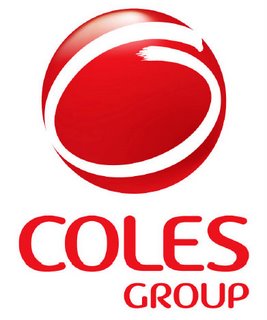
On Monday 1 August the Australian supermarket giant Coles went public with the results of their eagerly awaited nine month internal review. They were greeted by a lukewarm market reception and bewilderment as to the scope and nature of their new brand strategy.
Coles CEO, John Fletcher, said the newly named 'Coles Group Limited' (as we predicted in our blog on 13 July 2006) complete with a bright curly cue logo would "drive sales and earnings growth by further simplifying its business to invest in stores and customers’ shopping experience" by focussing on "customers’ everyday shopping needs".
The most interesting part of the announcement was the decision to integrate the existing food, liquor, fuel and general merchandise businesses (Coles Supermarkets, Liquorland, Vintage Cellars, 1stChoice Liquor Superstore, Coles Express and KMart) into something vaguely called "everyday needs".
While the Sydney Morning Herald's coverage on the same day seemed to interpret this to mean that everything would be called "Coles", our understanding is that while the Coles name would feature prominently in the newly branded business, this is not necessarily the case...
In addition, we are not convinced that calling something "Coles Everyday Needs" is particularly evocative of anything. Perhaps really what they are trying to do is simplify the group structure so that the process of marketing, supply chain and management can be centralised and significant savings made by reducing head office numbers and duplication at various management levels of the existing brands.
Fletcher claims that the Group will be spending $60 million to improve the customer experience in supermarkets and increasing investment in Target and Officeworks, which they have chosen to retain. Yet, why announce such a large spend working on what is demonstrably a poor experience (which you will be inevitably looking to rebrand over the next two years)?
“We have spent the last nine months researching our customers, team members, suppliers and the world’s best retailers to ensure there is overlap between our current and next strategic direction,” Fletcher said in the company release.
This is a very strange claim when both DIFFUSION and most market analysts remarked that the Group lacked any real strategic direction.
“During this time it has become clear that two key themes – customer intimacy and simplification – will drive future growth, enabling us to direct additional resources and focus to engaging our customers with better service, more convenience, and better products and rewards.”
Similarly, Fletcher's claims that these two themes are the bulwark of any future growth are also odds with a culture that to date has seemed to shun any notion of better service by reducing the ratio of staff to customer numbers, defined 'convenience' by opening hours, marginalised suppliers by screwing ever better deals and increasing its reliance on own brand products (see our blog on 18 March 2005) and vastly diminished rewards for customers by increasing eligibility thresholds.
Fletcher is now working on the idea that the "key to the new everyday needs business will be the creation of a lean and innovative culture in which stores are ‘heroes’, and where team members are empowered to deliver great service and products to customers.”
Fletcher's description of the new stores in terms of both "innovative" and "heroes" seem a contradiction in terms. Under his stewardship, the Group's brands have been denuded of any real intrinsic value and supported by bland propositions. The "everyday needs" proposition is equally fraught. Will the new store formats that Coles will invest something like $850 million in, become hypermarkets, along the lines of Carrefour or WalMart?
We don't know the answer because Coles and Fletcher is still working out the details of what can only be described as a strategy that not only views brand as the sum of a capital spend but also takes for granted the notion that customers are more interested in logos and fascias, rather than details of how they might actually get better service.